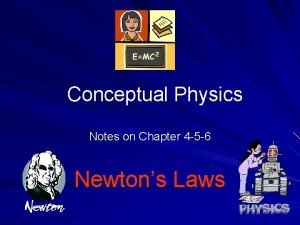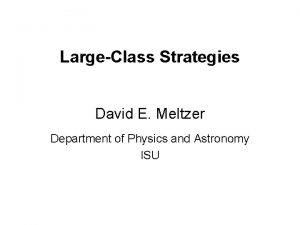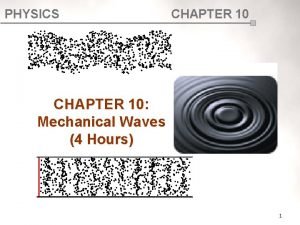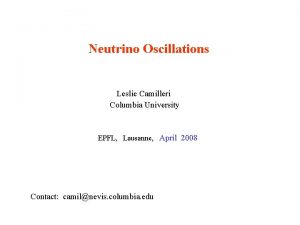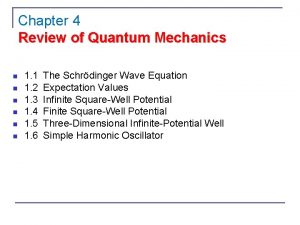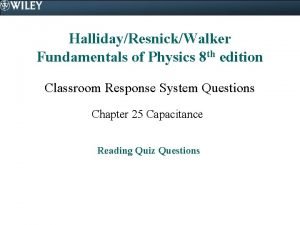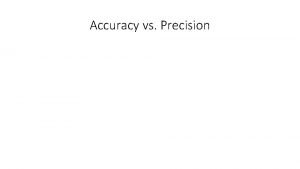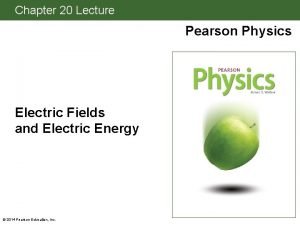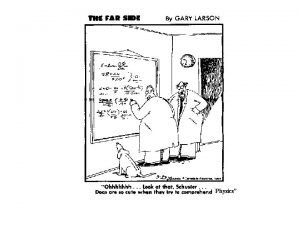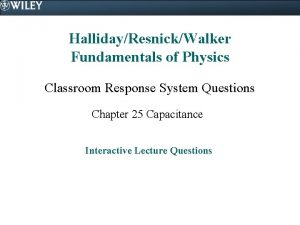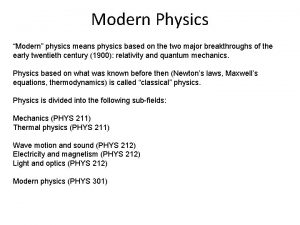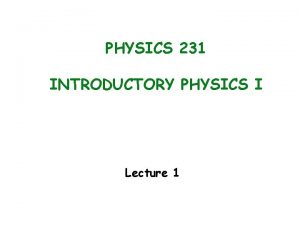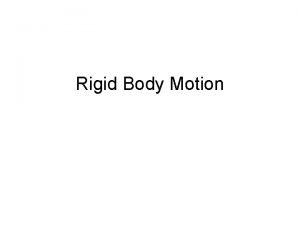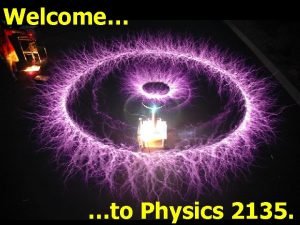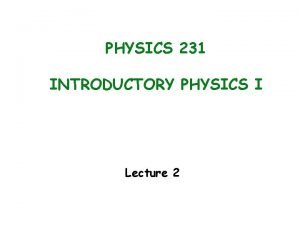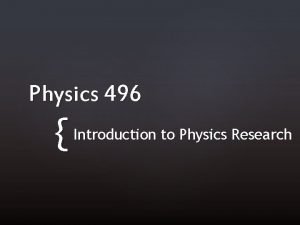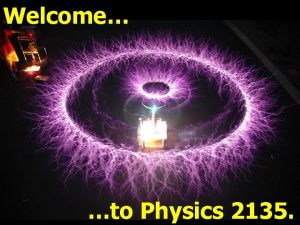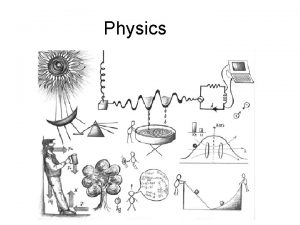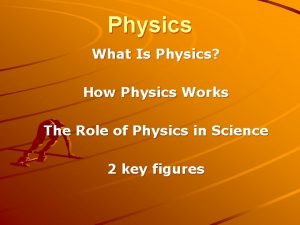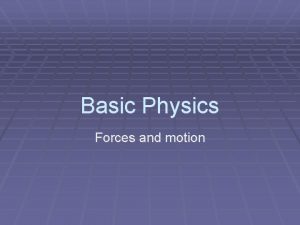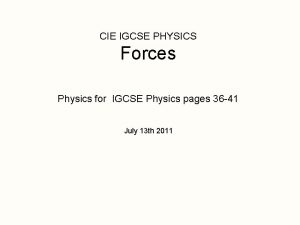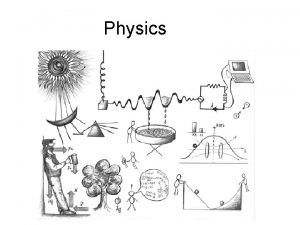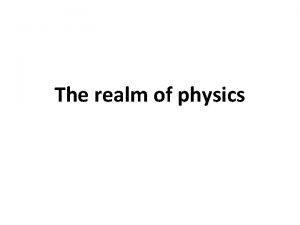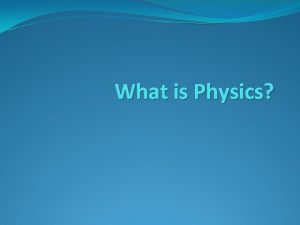What is Physics What is Physics Physics is























- Slides: 23

What is Physics?

What is Physics? • Physics is – the scientific study of the physical world: matter, energy, motion, and force. – The study of the fundamental laws of nature, which, simply put, are the laws that underlie all physical phenomena in the universe. • From a Greek term meaning "the science of nature. "

What is Physics? Continued • Physics is everywhere, in fact most people know more about it than they think they do – When you buy ice cream you know that you need to put it in the freezer. Why? Because it would melt otherwise. • Any problem that deals with temperature, size, motion, position, shape, or color involves physics. • We have remarkably found that these laws can be expressed in terms of mathematical equations.

Areas within Physics Name Subjects Examples Mechanics Motion and its causes, interactions between objects Falling objects, friction, weight, spinning objects Thermodynamics Heat and Temperature Melting and freezing processes, engines, refrigerators Vibrations and Wave Phenomena Specific types of repetitive motions Springs, pendulums, sound Optics Light Mirrors, lenses, color, astronomy Electromagnetism Electricity, magnetism, and light Electrical charge, circuitry, permanent magnets, electromagnets Relativity Particles moving at any speed, including very high speeds Particle collisions, particle accelerators, nuclear energy Quantum mechanics Behavior of submicroscopic particles The atom and its parts

This is Physics!!

SI Units Quantity Name SI Abbreviation Length Meter m Mass Kilogram kg Time Second s Electric current Ampere A

SI Prefixes • Prefixes are used to change the size of the base unit. Used instead of writing a lot of zeroes.

Conversion Factors • Conversion factor – A ratio of equivalent measurements. – Useful in solving problems in which a given measurement must be expressed in some other unit of measurement.

Dimensional Analysis • Dimensional analysis – A way to analyze and solve problems using the units of the measurements.


Converting Between Units

Multistep Problems

Converting Complex Units

Practice Problems • A minivan sells for 33, 200 dollars. Express the price for a minivan in kilodollars and Megadollars? • A Typical E. coli bacterium is about 5 micrometers in length. Give the length in millimeters and kilometers. • How many seconds are in a leap year? • Convert the speed 5. 30 m/s to km/h.

Scientific Notation • Scientist often deal with very large or very small numbers. These numbers can be expressed in powers of 10 • Numbers take the form of – M X 10 n • Where M = a number 1 – 10 • And n = the number of decimal places moved

Conversions using Scientific Notation with large numbers • Ex 1 • Convert 1, 500, 000 to scientific notation. • First move the decimal place so that there is only one digit to its left • 1. 5 • How many spaces did we move them? • 6 • So we write it as • 1. 5 x 106

• • Conversions using Scientific Notation with small numbers Ex 1 Convert. 000025 to scientific notation First move the decimal 2. 5 How many places did we move it? 5 So we write it as: 2. 5 x 10 -5 (note: since the number was less than one it is written as a negative number)

Sample Problems • Convert the following: – 5. 65 x 106 – 4. 90 x 10 -4 –. 000000045 –. 0000067

Using Scientific Notation • Multiplication – The base numbers are multiplied and the exponents are added. • (4. 0 x 103)(2. 0 x 103) = • Division – The base numbers are divided and the exponents are subtracted. • (1. 06 x 104)/(2. 0 x 10 -2) = • Addition or subtraction – Express all the exponents in the same power of 10. Perform the addition or subtraction, then if necessary convert to correct form of scientific notation. • 7. 11 x 104 + 4. 0 x 103 =

Significant Figures (Sig Figs) • All Digits 1 -9 are significant – – • Zeros between significant digits are significant – – • 100. 0 4 sig figs 100 1 sig fig Zeros in the beginning of a number whose only function is to place the decimal points are not significant – – • 5, 007 4 sig figs Trailing zeros are only significant if the number contains a decimal point – – • 129 3 sig figs 0. 0025 2 sig figs Zeros following a decimal significant figure are significant – – 0. 000470 3 sig figs 0. 47000 5 sig figs

Calculations using Sig Figs • When multiplying or dividing – Round to the least number of sig figs • When adding or subtracting – Round to the least amount of decimal places

Sample Problems • • 6. 201 cm + 7. 4 cm +. 68 cm + 12. 0 cm 10. 8 cm - 8. 264 cm 139 cm x 2. 3 cm 18. 21 g 4. 4 g

Today’s Homework • Page 9 – 1, 2 • Page 20 – 1, 2, 3, • Pages 27 – 31 – 1, 2, 5, 7, 8, 11, 13, 16, 18, 19, 20, 21, 22
 Modern physics vs classical physics
Modern physics vs classical physics University physics with modern physics fifteenth edition
University physics with modern physics fifteenth edition Ia physics ideas
Ia physics ideas Fv physics
Fv physics Cern particle physics
Cern particle physics A coin sits on a turntable
A coin sits on a turntable Conceptual physics notes
Conceptual physics notes Why is the sky blue physics?
Why is the sky blue physics? David meltzer physics
David meltzer physics Nsl physics
Nsl physics Ucsd eduroam
Ucsd eduroam Formula for time of flight in projectile motion
Formula for time of flight in projectile motion Displacement formula
Displacement formula Leslie camilleri physics
Leslie camilleri physics Site:slidetodoc.com
Site:slidetodoc.com Peter fisher mit
Peter fisher mit Normalize wave function e^ix
Normalize wave function e^ix Vce physics study design
Vce physics study design Farad is equivalent to
Farad is equivalent to Accuracy v precision in chemistry
Accuracy v precision in chemistry Pearson
Pearson Angle of banking
Angle of banking Hubble's constant higher physics
Hubble's constant higher physics Capacitance physics classroom
Capacitance physics classroom






